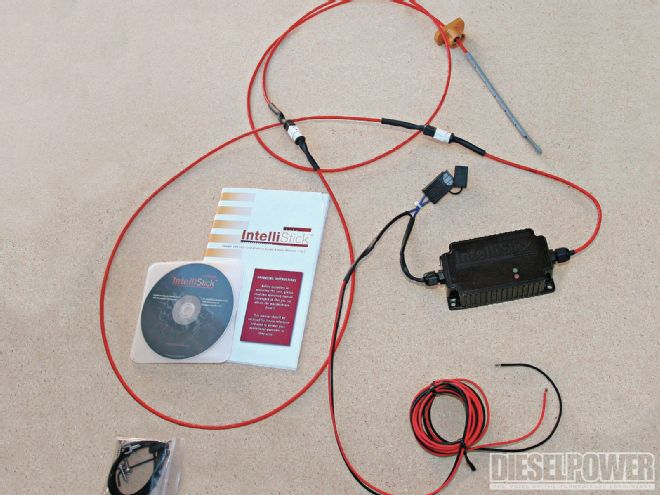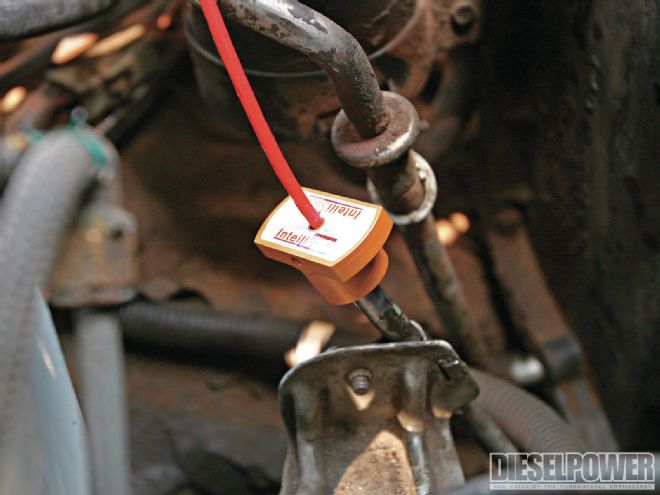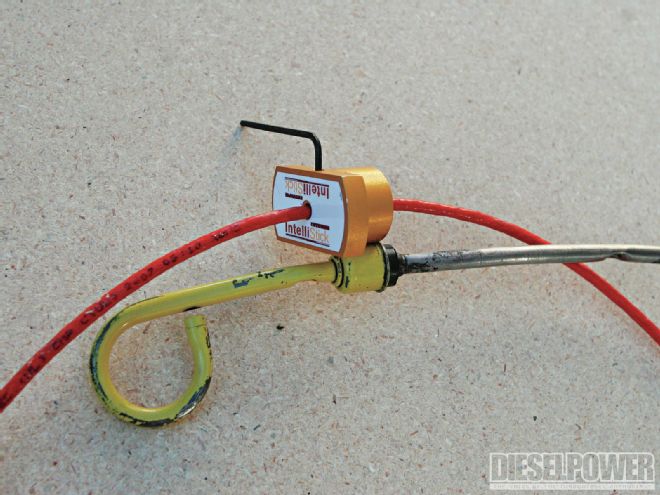We here at Diesel Power feel bad every time we hear about one of you losing an engine. If the motor ran good for decades without many problems, we can accept the passing after a little mourning. Although, if it was a fresh, young motor that lost its life due to a bad injector, failed head gasket, or other minor problem, there is wailing and gnashing of teeth. We’re happy to report the days of driving without knowing the real-time condition of your engine oil are over.

| 1104dp Intelligent Oil Dipstick Prevents Engine Failures stock And Intellistick Dipstick
Intellistick: The Intelligent Dipstick
We installed the IntelliStick intrusion and oil condition monitoring system in less than an hour. This is possible because the sensor simply replaces the factory dipstick. This system was originally developed for the U.S. Army and works by analyzing the signal from two arrays of electrodes that stimulate the oil with a low voltage and frequencythen measures the conductivity. This data is sent to the analyzer box, which processes and stores the data for up to two weeks. It also sends out this information via a Bluetooth signal that can be displayed on a laptop or smartphone.
If the oil’s conditions should fall outside the parameters, a warning is sent alerting the driver that something is critically wrong with the engine. The analyzer box has two lights: a red one that lights when there is something wrong, and a green one that lights when the system is communicating and the oil is in its safe parameters. Other options include a dash-mounted gauge, which displays oil condition data.
Kauffman Conductance Curve:
Stage 1: The conductance reading is declining because the lubricity, antioxidant, and detergent packages in the oil are getting used up. The software shows a big arrow for a quick indicator of the trend in the graph.
Stage 2: When the conductance reading doesn’t change, this means the lubricity additive package is almost entirely gone and the oil lubricity is strongly dependent on the base oil. A small amount of polishing wear may be occurring on the engine. This second stage may have a gradual rise, because the antioxidant package is starting to lose its capability to stop basestock oxidation.
Stage 3: The conductance is increasing due to the buildup of oxidation by-products. This means the oil is oxidizing, breaking down, and further losing its ability to lubricate. Engine polishing wear is accelerating.
Stage 4: When the reading starts to level out, this indicates the viscosity of the oil is increasing and the severity of engine wear is increasing.

| 1104dp Intelligent Oil Dipstick Prevents Engine Failures kauffman Conductance Curve
Capabilities
Detects water intrusion: The array of electrodes has a particular spacing that makes it sensitive to water or coolant droplets suspended in the oil. An increase in the ratio between the two array outputs signals their presence. Getting water in the oil could be caused by a leaking oil cooler, ruptured head gasket, or leaking injector cups.
Detects fuel intrusion: This is because the fuel decreases the viscosity of the oil and tends to oxidize rapidly. Seeing a relatively sharp increase in conductance reading at an unexpected point on the curve may mean there is fuel leaking into the oil. A bad injector, leaking return line, or extremely worn rings could cause this intrusion, which leads to engine breakdown.
Low oil level: A change in conductivity also warns if oil is dangerously low. A carelessly tightened oil plug, blown oil filter, or leaking oil line could cause this potentially catastrophic situation.
Knowledge is power: You can now objectively compare filters, oils, and additives. This information can be saved over the engine’s lifetime and can be sent along to the next ownerincreasing the resale value. Longer engine oil change intervals are also an option since the IntelliStick detects if the additives have been depleted and also checks for oil viscosity and oxidation.
Monitors operating temperature: The IntelliStick system is always on but only starts monitoring when the operating temperature exceeds 150 degrees. Pete Trasborg of JP magazine said the system did not drain his batteries even after it was left to sit for one month.
Tips From The Pros
Regularly scheduled oil changes based on service will probably be the best practice.Oil sampling devices may be good for pinpointing failures that would contaminate the oil, such as a blown head gasket or coolant or fuel leak, but I don’t see it as the sole criterion for determining oil change intervals. For example, soot loading will not be a very big contributor to conductivity. I recommend 3,000-mile changes using Delo 400 or Shell Rotella T. Diesel oils have more additive content than conventional gasoline engine oils, and that keeps engines clean. I guess I spent too many years formulating oils to not believe that changing oil at a regular interval is important.
Dr. Robert L. Freerks Oil Lubrication Specialist


